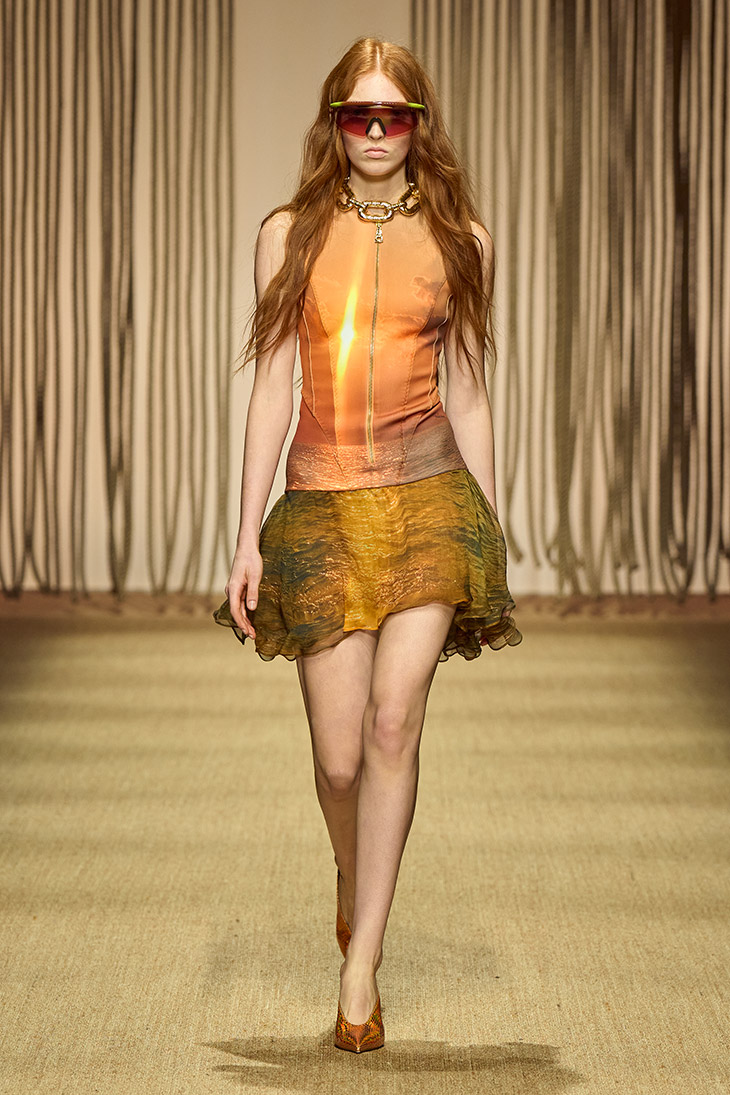
Fausto Puglisi’s Spring Summer 2025 collection for Roberto Cavalli is a celebration of place, history, and personal vision. Rooted in the essence of Zancle, the ancient name of Messina, this collection pays homage to Puglisi’s Sicilian heritage while channeling the untamed energy of Roberto Cavalli’s legacy. The designer, known for his dramatic flair, blends the rich textures, colors, and elements of his birthplace into a collection that feels both evocative and fresh, merging his islander past with the international fashion house’s iconic status.
The narrative of the collection unfolds like a journey through Messina. The show’s crescendo mirrors the city’s scenery, from the worn graffiato textures of the houses to the ropes and chains used by local fishermen, now reimagined as dresses and accessories. The materials reflect the rugged beauty of Sicily, with an emphasis on natural fabrics like jute, raffia, cotton, and silk. Puglisi’s use of linen and laminated silk brings a tactile quality to the pieces, ensuring they feel grounded in the natural world. This sensory connection to Messina imbues the collection with a profound sense of place, while still carrying the sensuality and drama that are hallmarks of the Cavalli aesthetic.



The first half of the collection starts in a minimalist palette of whites and ecru, emphasizing clean lines and a sculptural approach to design. Puglisi’s restraint here allows the textures to shine: nets are embroidered onto trench coats, while draped dresses and loose pants move with a casual elegance. The absence of prints in these initial looks draws attention to form and structure, with each piece carefully constructed to evoke a sense of ease.
As the collection progresses, it takes on the colors of the sea. A vibrant red sunset over the Strait of Messina is captured in silk jacquards and froissé fabrics, creating an interplay of light and movement that recalls the shifting skies at dusk. The transition into shades of deep blue marks the full immersion into the waters surrounding Sicily. Dresses and suits ripple like waves, their fluidity creating a dynamic energy on the runway. Puglisi’s siren-like silhouettes, covered in sequins, close the show, evoking both the allure of the sea and the mythological seduction that has long fascinated cultures around the Mediterranean.



In addition to its material richness, the collection is also a story of shapes. Puglisi emphasizes asymmetry, particularly in his draping and the way the garments flow across the body. The use of woven raffia and paper adds an artisanal quality, a nod to traditional craftsmanship reinterpreted for a modern audience. Puglisi’s thoughtful layering of textures and materials creates depth and dimension, enhancing the visual complexity of the collection.
This collection also marks a poignant moment for the house of Roberto Cavalli. It is the first show since the founder’s passing, and Puglisi pays tribute by revisiting some of the brand’s most iconic pieces. Seven designs from Cavalli’s early 2000s archives made a dramatic return to the runway, each a symbol of the late designer’s fearless creativity. Asymmetric zebra print slip dresses from Fall/Winter 2000, a black leather and chiffon siren gown from Fall/Winter 2003, and feathered gowns from Fall/Winter 2004 were reintroduced as part of this retrospective. These selections highlight Cavalli’s ability to merge wild, animalistic elements with high fashion glamour, encapsulating his daring spirit.



In a nod to Cavalli’s enduring influence, the show also debuted a capsule collection titled “Zebra 2000.” This contemporary reimagining of the classic zebra print includes slip dresses, shirts, t-shirts, bodysuits, and jeans in various colorways. Available for purchase immediately after the show, this collection brings Cavalli’s signature print into the present, allowing a new generation to experience the boldness that defined his brand.
Fausto Puglisi’s Spring Summer 2025 collection for Roberto Cavalli is both a tribute and a statement. It honors the past while forging a new path for the house, one that is deeply connected to the natural world and the designer’s personal history.




















